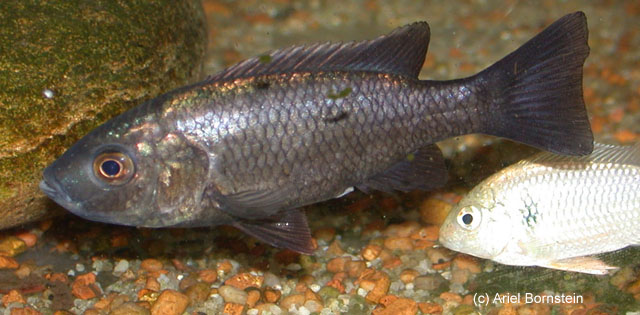| Cichlidae (Cichlids), subfamily: Pseudocrenilabrinae |
| 6.65 cm SL (male/unsexed) |
|
demersal; freshwater |
| Africa: endemic to Lake Barombi Mbo, Cameroon (Ref. 81260). |
|
Dorsal spines (total): 14-15; Dorsal soft rays (total): 10-12; Anal spines: 3-3; Anal soft rays: 8-10; Vertebrae: 28-29. Diagnosis: mouth strongly upturned, making an angle of about 50° with the horizontal; outer row jaw teeth reduced and few in number, inner row teeth minute tricuspids; lower pharyngeal jaw markedly longer than wide, with a reduced dentigerous surface, and covered with a ‘felt’ of tiny unicuspid teeth (Ref. 81260).
Description: body relatively robust (body depth 32.0-35.5% SL) (Ref. 81260). Head large (37.0-44.0% SL) (Ref. 81260), somewhat pointed (Ref. 52307). Mouth at an angle of about 50° with the horizontal (Ref. 53940). Lower jaw usually slightly projecting (Ref. 53940), long (33.0-39.0% HL) and steeply inclined (Ref. 81260). Mesethmoid free from vomer (Ref. 53940). Teeth in oral jaws very small (Ref. 53940, 81260) and in 2 series (Ref. 53940), inner row teeth minute tricuspids, outer row teeth small, often shouldered, conical or truncate unicuspids (Ref. 81260). Eye large (diameter 23.0-29.0% HL). Gill rakers short (Ref. 53940, 81260). Lower pharyngeal jaw markedly longer than wide, elongate ventral keel 3.5-5 times length of dentigerous surface (Ref. 81260); dentigerous surface restricted (Ref. 53940). Pharyngeal teeth very weak; scales cycloid, with concentric circuli; microbranchiospines present on second, third and fourth arches; pelvic fins reach anus or genital papilla (Ref. 53940).
Coloration: body dark grey with a silvery to greenish flush in both sexes (Ref. 52307, 53940, 81260). Pelvic fins usually yellow; "tilapia"-mark absent (Ref. 53940, 81260). Courting males turn bluish-black to black with equally colored fins (Ref. 52307). |
| Prefers open water regions at greater depths, but ventures into the more shallow areas of the lake for spawning, which normally occurs during the rainy season; mainly feeds on phytoplankton and small insects; probably ovophilic mouthbrooder; males occupy a tertitory of ca. 50 cm and it is often possible to find large numbers of males in a limited area (Ref. 52307). |
|
Critically Endangered (CR); Date assessed: 16 February 2009 (B1ab(iii)+2ab(iii)) Ref. (130435)
|
| harmless |
Source and more info: www.fishbase.org. For personal, classroom, and other internal use only. Not for publication.
